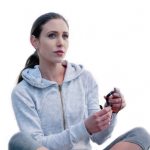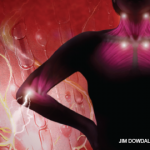Given the explosive prevalence of Type 2 diabetes, glucose monitoring has become another intense area of interest. Continuous glucose monitoring can be achieved using a patch or an implanted sensor that periodically checks the glucose level in a user’s subcutaneous tissues and sends the results wirelessly to their phone.3 In an effort to avoid the often dreaded needlestick, engineers at Google are developing contact lenses containing tiny wireless chips and sensors that would measure and transmit the glucose levels in a diabetic patient’s tears.
For the neurotic parents among us, there’s the burgeoning field of “baby wearables,” or clothing embedded with sensors that can transmit an infant’s vital signs and respirations to data-driven (aka anxious!) parents.
Are there any m-health apps that might be suitable for our rheumatology patients? Given the chronicity of many of the diseases that we treat, there has been a focus on collecting behavioral data that may help us better understand how well or how poorly our patients are functioning on the many days between their office visits. Two types of information are collected. Using a smartphone app, patients regularly enter self-reported data through surveys, such as the health assessment questionnaire (HAQ) or other measures of their functional status. Most importantly, this information is supplemented by the collection of data from their phones’ sensors that can measure mobility (in miles) and social interaction (the daily number of phone calls, text messages). More data points should provide more robust data.
There are now sensors that, when fitted into shoes, continuously analyze a patient’s gait. This technology might be useful in developing more customized rehabilitation programs for patients with osteoarthritis.
One of the great challenges in developing m-health apps for our specialty is the difficulty in pinpointing what needs to be measured. After all, where does the immune system reside? Unlike the cardiovascular system or the brain, the whereabouts of the immune system are not readily known. Continuous, in vivo measurements of cytokines and other potential biomarkers circulating in the bloodstream would not provide us with superior data compared to the current ways of getting results by drawing a blood sample. At the present time, the likelihood of a disruptive technology changing our clinical practice seems slim.
On the other hand, there have been some great advances on the musculoskeletal side of rheumatology. A highly innovative form of wearable technology was recently described in Science.4 An international team led by a group of researchers at the University of Texas in Dallas demonstrated that ordinary fishing line and sewing thread could be cheaply converted to create powerful artificial muscles. Twisting together a bundle of polyethylene fishing lines, whose total diameter was only about 10 times larger than a human hair, produced a coiled polymer muscle that could lift 16 pounds. Operated in parallel, similar to how natural muscles are configured, 100 of these could lift about 1,600 pounds. You wouldn’t want to mess with this patient!
There are now sensors that, when fitted into shoes, continuously analyze a patient’s gait. This technology might be useful in developing more customized rehabilitation programs for patients with osteoarthritis.
The Avatar Doctor
Our fishing line enhanced superhuman sounds like a character straight out of a Robin Cook novel. Robin Cook, MD, an ophthalmologist by training, is best known as a prolific writer of the medical mystery genre. In his latest thriller, Cell, the smartphone is poised to take on a new role in medicine, no longer as a mere medical app but as a fully customizable personal physician capable of diagnosing and treating diseases even better than a human doctor.5 Known as the iDoc, it runs amok under the control of—you guessed it—an evil insurance company. The story’s protagonist, George Wilson, MD, a radiology resident, awakens one morning to find his fiancée dead in bed alongside him, not long after she participated in an iDoc beta test. After undergoing imaging procedures, several of his patients who had been part of the same beta test are found dead.



